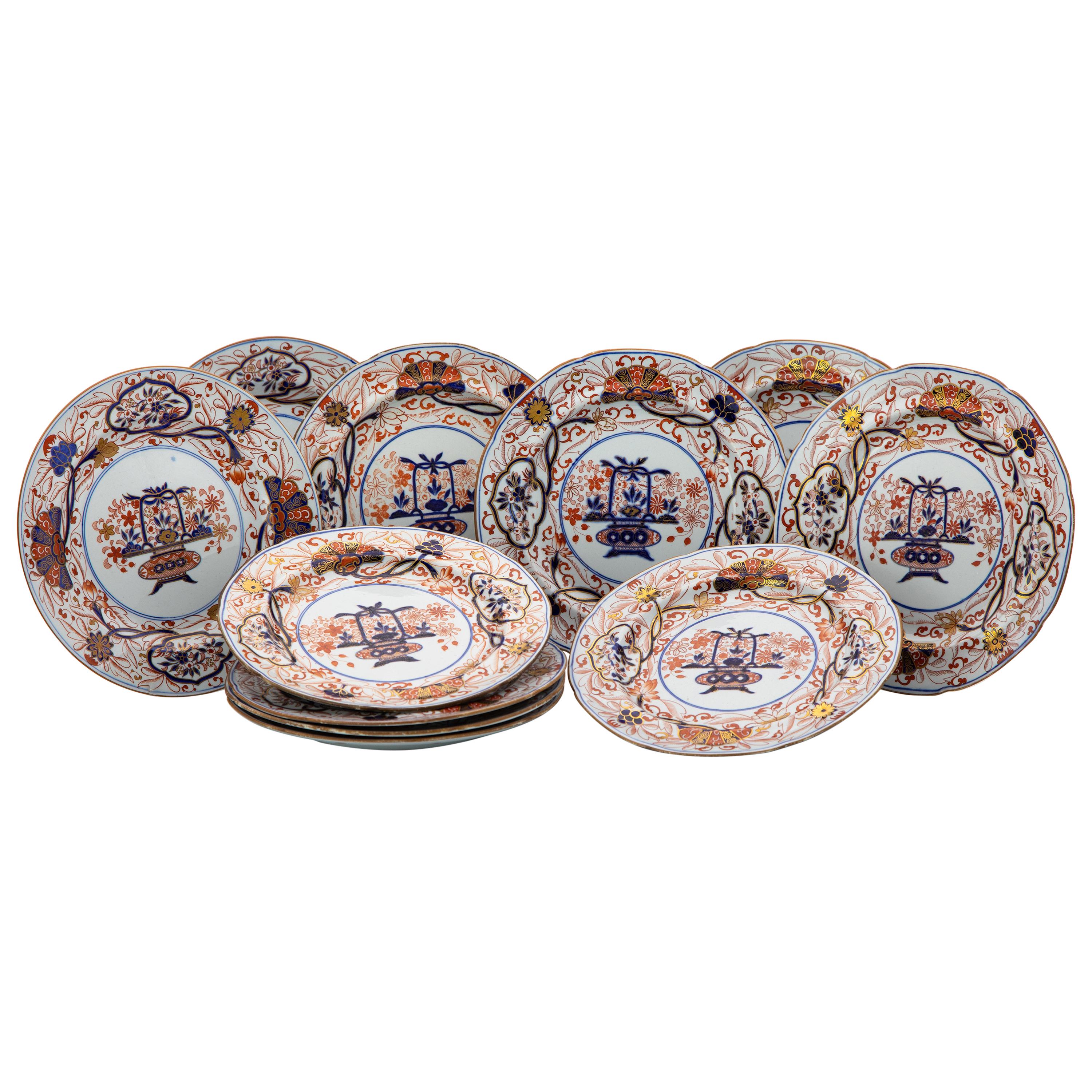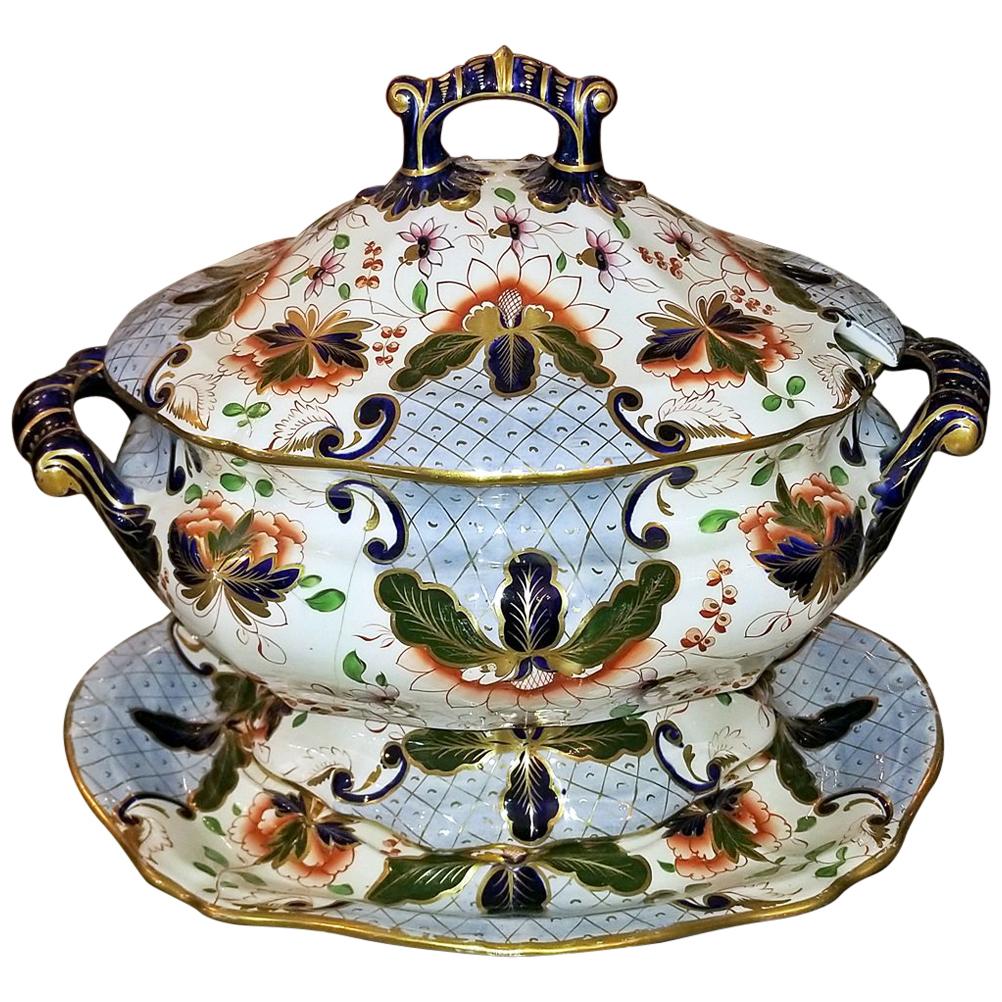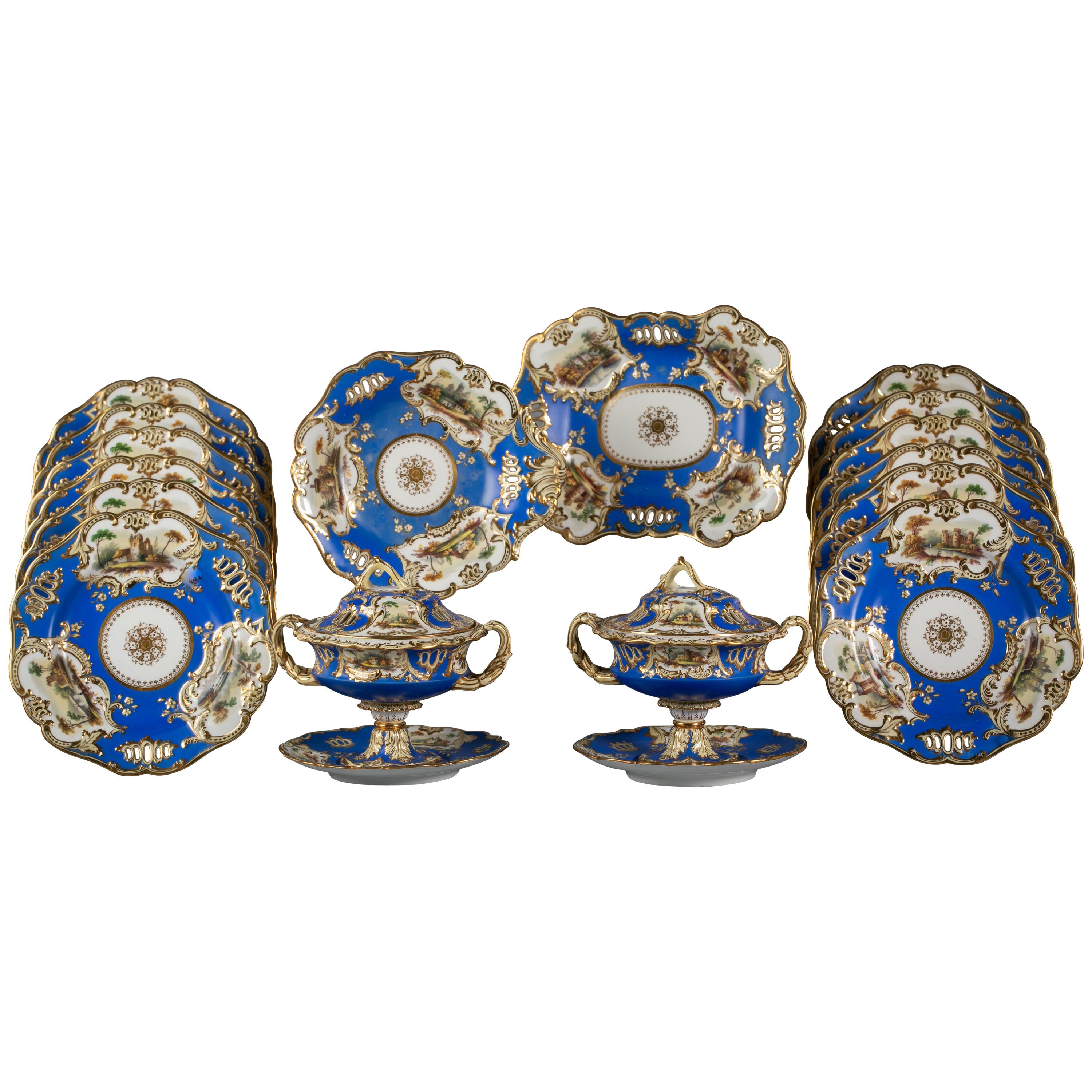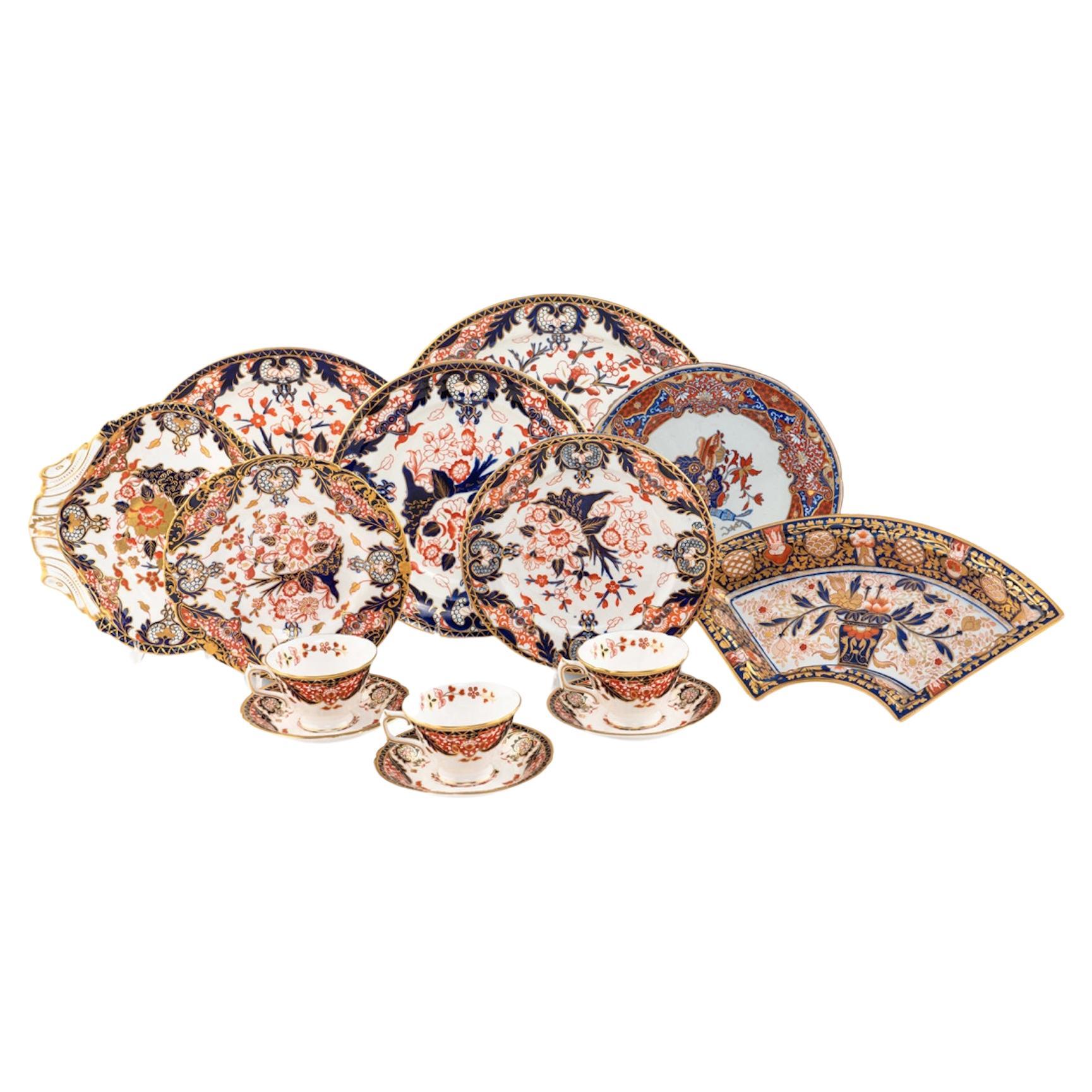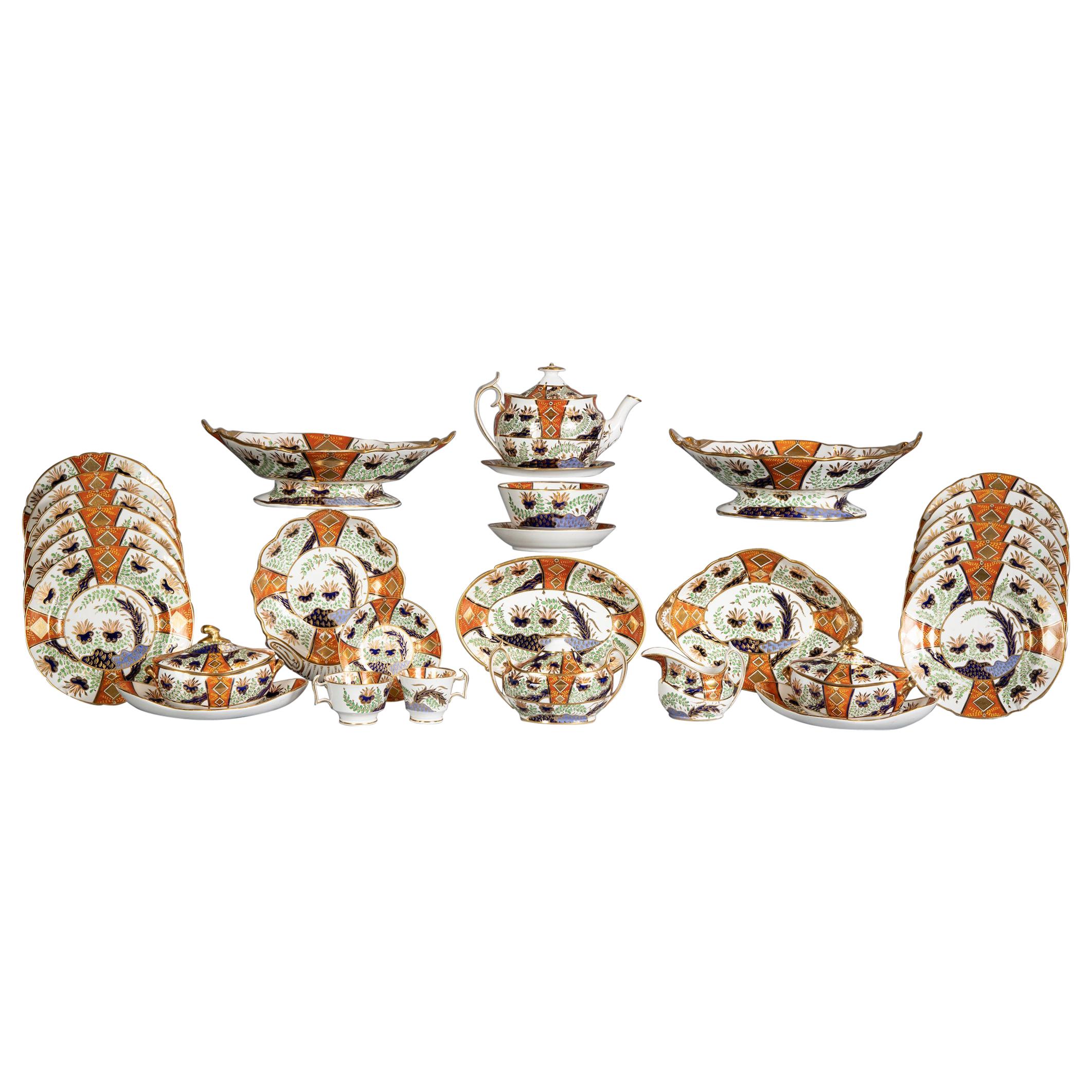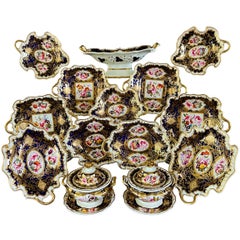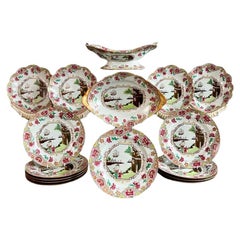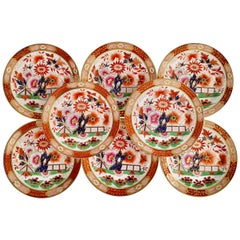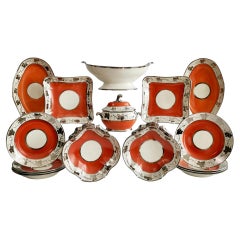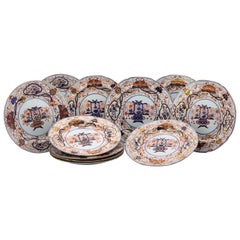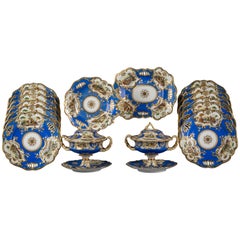Items Similar to Coalport John Rose Porcelain Dessert Service, Imari Pattern, ca 1805
Video Loading
Want more images or videos?
Request additional images or videos from the seller
1 of 17
Coalport John Rose Porcelain Dessert Service, Imari Pattern, ca 1805
$3,360per set
$4,200per set20% Off
£2,499.27per set
£3,124.09per set20% Off
€2,926.15per set
€3,657.69per set20% Off
CA$4,688.34per set
CA$5,860.43per set20% Off
A$5,246.39per set
A$6,557.98per set20% Off
CHF 2,739.42per set
CHF 3,424.27per set20% Off
MX$64,498.84per set
MX$80,623.56per set20% Off
NOK 34,560.89per set
NOK 43,201.11per set20% Off
SEK 32,521.63per set
SEK 40,652.03per set20% Off
DKK 21,831.35per set
DKK 27,289.19per set20% Off
Shipping
Retrieving quote...The 1stDibs Promise:
Authenticity Guarantee,
Money-Back Guarantee,
24-Hour Cancellation
About the Item
This is a rather stunning 25-piece dessert service made by John Rose at Coalport around the year 1805. It consists a centre piece on four feet, two oval dishes, two shell dishes, two square dishes, two sauce tureens with covers and stands, and twelve plates.
I have six more plates available, which will be up in the shop soon and which I'd be happy to add at a good discount.
Coalport was one of the leading potters in 19th and 20th Century Staffordshire. They worked alongside other great potters such as Spode, Davenport and Minton, and came out with many innovative designs. When we say "Coalport" we usually think of the one Coalport factory that became famous, but in its beginning years there were two factories, one run by John Rose and the other by his brother Thomas Rose. Thomas Rose went into partnership with Robert Anstice and Robert Horton and they were located directly opposite John Rose, across the canal. The brothers' factories had much in common with each other and they shared many different shapes and patterns. Ultimately, the John Rose factory proved more profitable and John Rose bought Thomas' factory in 1814, making it the one Coalport factory that became so famous. Many of the Coalport items, of either factory, are now collectors' items.
The set is made of early porcelain, from before the time that bone china became the standard; you can see that the porcelain is slightly greyish and a little uneven in places.
This type of pattern was called the "Japan" style, and it was imitating the beautiful Imari style from Arita, Japan. The style became very popular in the early 19th Century. Today, we call it the "Imari" style, as this type of porcelain was shipped out of the harbour of Imari. There were many of these patterns around; this one is exceptionally beautiful with a large exotic flower held in a wreath, a cute underglaze blue boundary, and a rim with roots and flowers.
The items are unmarked, as is usual for that era.
An unusual and very rare feature of this service is that sauce tureens; they have handles and knobs in the shape of sun-like medalions - something I have never seen before.
Provenance: there are old Sotheby's New York labels on many of the items; the service has been part of the Frank Herrmann collection.
CONDITION REPORT The service is in excellent condition with only a few flaws: one of the tureen covers has been broken and is repaired with rivets - it is not entirely stable but still fine to use; one of the tureens has its side handle riveted; a couple of plates have some crazing. Other than this, there is hardly any wear, no damage, and no other repairs. The entire service is good for use and of course stunning on display.
Antique British porcelain is never perfect. Kilns were fired on coal in the 1800s, and this meant that china from that period can have some firing specks from flying particles. British makers were also known for their experimentation, and sometimes this resulted in technically imperfect results. Due to the shrinkage in the kiln, items can have small firing lines or develop crazing over time, which should not be seen as damage but as an imperfection of the maker's recipes, probably unknown at the time of making. Items have often been used for many years and can have normal signs of wear, and gilt can have signs of slight disintegration even if never handled. I will reflect any damage, repairs, obvious stress marks, crazing or heavy wear in the item description but some minor scratches, nicks, stains and gilt disintegration can be normal for vintage items and need to be taken into account.
There is widespread confusion on the internet about the difference between chips and nicks, or hairlines and cracks. I will reflect any damage as truthfully as I can, i.e. a nick is a tiny bit of damage smaller than 1mm and a chip is something you can easily see with the eye; a glazing line is a break in the glazing only; hairline is extremely tight and/or superficial and not picked up by the finger; and a crack is obvious both to the eye and the finger. Etcetera - I try to be as accurate as I can and please feel free to ask questions or request more detailed pictures!
DIMENSIONS centre piece 26cm X 20cm (10.25" X 8") and 9cm (3.5") tall; plates 21.5cm (8.5") diameter.
- Creator:Coalport Porcelain (Maker),John Rose (Maker)
- Dimensions:Height: 1 in (2.54 cm)Width: 1 in (2.54 cm)Depth: 1 in (2.54 cm)
- Sold As:Set of 25
- Style:George III (Of the Period)
- Materials and Techniques:
- Place of Origin:
- Period:
- Date of Manufacture:ca 1805
- Condition:Wear consistent with age and use. The service is in excellent condition with only a few flaws: one of the tureen covers has been broken and is repaired with rivets - it is not entirely stable but still fine to use; one of the tureens has its side handle riveted; a few plates crazed.
- Seller Location:London, GB
- Reference Number:Seller: A-COA2911stDibs: LU4805137687202
About the Seller
5.0
Gold Seller
Premium sellers maintaining a 4.3+ rating and 24-hour response times
Established in 2016
1stDibs seller since 2019
225 sales on 1stDibs
Typical response time: 2 hours
- ShippingRetrieving quote...Shipping from: London, United Kingdom
- Return Policy
Authenticity Guarantee
In the unlikely event there’s an issue with an item’s authenticity, contact us within 1 year for a full refund. DetailsMoney-Back Guarantee
If your item is not as described, is damaged in transit, or does not arrive, contact us within 7 days for a full refund. Details24-Hour Cancellation
You have a 24-hour grace period in which to reconsider your purchase, with no questions asked.Vetted Professional Sellers
Our world-class sellers must adhere to strict standards for service and quality, maintaining the integrity of our listings.Price-Match Guarantee
If you find that a seller listed the same item for a lower price elsewhere, we’ll match it.Trusted Global Delivery
Our best-in-class carrier network provides specialized shipping options worldwide, including custom delivery.More From This Seller
View AllSamuel Alcock Dessert Service for 12, Cobalt Blue, Gilt and Flowers ca 1822
By Samuel Alcock & Co.
Located in London, GB
A magnificent large complete dessert service consisting of a high footed centre piece, four rectangular dishes, four oval dishes, three leaf dishes, two sauce tureens with covers and...
Category
Antique 1820s English Regency Dinner Plates
Materials
Porcelain
$12,500 / set
Free Shipping
Spode Dessert Service, Ship Pattern no. 3133 on Stone China, 1813-1822
By Spode
Located in London, GB
This is a stunning and rare Spode dessert service made between 1813 and 1822, consisting of a centre piece, a lozenge shape dish, four shell dish...
Category
Antique 1810s English Regency Porcelain
Materials
Stoneware
Set of 8 Barr Flight & Barr Porcelain Plates, Imari Fence, Regency, 1811-1813
By Barr, Flight & Barr Worcester
Located in London, GB
This is a spectacular set of eight plates made by Barr Flight & Barr between 1811 and 1813. They are made in one of the many versions of the "Imari Fence" or "Japan" pattern.
Barr...
Category
Antique 1810s English Regency Dinner Plates
Materials
Porcelain
$5,950 / set
Free Shipping
Coalport John Rose Pearlware Dessert Service, Orange with Silver Vines, ca 1800
By John Rose, Coalport Porcelain
Located in London, GB
This is a stunning and extremely rare dessert service made by John Rose at Coalport probably around the year 1800, shortly after Rose bought up the Caughley factory. It consists of a large centre piece comport, one sauce tureen with cover, two oval dishes, two square dishes, two shell dishes, and eight plates. The service is beautifully decorated in the Neoclassical style.
Coalport was one of the leading potters in 19th and 20th Century Staffordshire. They worked alongside other great potters such as Spode, Davenport and Minton, and came out with many innovative designs. When we say "Coalport" we usually think of the one Coalport factory that became famous, but in its beginning years there were two factories, one run by John Rose and the other by his brother Thomas Rose. Thomas Rose went into partnership with Robert Anstice and Robert Horton and they were located directly opposite John Rose, across the canal. John Rose had bought up the local Caughley factory in 1799. The brothers' factories had much in common with each other and they shared many different shapes and patterns. Ultimately, the John Rose factory proved more profitable and John Rose bought Thomas' factory in 1814, making it the one Coalport factory that became so famous. Many of the Coalport items, of either factory, are now collectors' items.
This service is made of pearlware, which leads us to believe that it might have been made at the old Caughley premises, which had kilns for pearlware - the later Coalport items are not known to be made of pearlware but the shape of the dishes and the sauce comport are clearly a Coalport shape.
All items have a beautiful deep orange ground - they were done in different firings as the colour is not entirely consistent, which makes the service very charming. The rims are set off with a beautiful vine pattern in silver, which makes the service even more rare as this was not done often.
The items are unmarked, as is usual for that era, except the odd "B", which is probably the gilder's tally mark.
CONDITION REPORT The service is in good usable condition with some minor flaws: there is some crazing and wear throughout, which is to be expected of pearlware of this era. The centre piece comport has a slight crack through the side, which is not very visible. One of the plates has a chip on the front of the rim as well as three lines coming off the rim; one has a chip on the underside of the rim; and one has a line coming off the rim. Neither of these stand out and the plates are entirely stable.
Antique British china...
Category
Antique Early 1800s British Neoclassical Dinner Plates
Materials
Pearlware
$3,750 / set
Free Shipping
Minton Dessert Service, Inverted Shell White with Monochrome Flowers, ca 1830
By Minton
Located in London, GB
This is a stunning dessert service made by Minton probably around the year 1830, in their "second period". The service consists of a high footed centre piece, two square dishes, two ...
Category
Antique 1830s English Rococo Revival Dinner Plates
Materials
Porcelain
$5,325 / set
Free Shipping
Derby Porcelain Part Dessert Service, Red Botanical, John Brewer, 1795-1800
By Crown Derby, John Brewer
Located in London, GB
This is a stunning part-dessert service made by Derby between about 1795 and 1800, painted with named botanical studies by John Brewer. The service consists of a lidded sauce comport on a stand, two kidney shaped dishes, two lozenge shaped dishes, one lozenge shaped low footed comport...
Category
Antique 1790s English George III Dinner Plates
Materials
Porcelain
$11,500 / set
Free Shipping
You May Also Like
Set of 11 Early Spode Ironstone Imari Dessert Dishes Made circa 1815
By Spode
Located in Fort Lauderdale, FL
A set of 11 Imari style ironstone dessert dishes, made by Spode circa 1815.
Josiah Spode II began producing stone china in 1813 as an alternative to porcelain. Stone china, also kno...
Category
Antique Early 19th Century English Regency Dinner Plates
Materials
Ironstone
Amazing Early 19C Davenport Longport Imari China Dinner Service
By Davenport Porcelain
Located in Dallas, TX
PRESENTING an AMAZING, EXTREMELY RARE and EXTENSIVE Early 19C Davenport Longport Imari China Dinner Service from circa 1805-1820.
HIGH REGENCY PERI...
Category
Antique Early 19th Century English George III Porcelain
Materials
Porcelain
Fine English Porcelain Dessert Service, Minton, circa 1830
Located in New York, NY
Comprising 24 plates, pair of covered sauce tureens and stands, pair of shell dishes and a pair of rectangular dishes. The bright blue ground inters...
Category
Antique 1830s English Dinner Plates
Materials
Porcelain
A Royal Crown Derby Porcelain Dinner Service 19th/20th Century Kings pattern
By Royal Crown Derby Porcelain
Located in Buchanan, MI
A Royal Crown Derby Porcelain/ironstone Assembled Dinner Service
19th/20th Century
Kings pattern, in slight variations throughout, comprising:
12 dinner plates
11 luncheon plates
12 ...
Category
Antique 19th Century English George III Dinner Plates
Materials
Porcelain
English Porcelain Cobalt Ground Dessert Service, Circa 1830
Located in New York, NY
Comprising a tazza (height 6.75", diameter 9.25"), two smaller tazza; a sauce tureen and cover; twelve plates; and one smaller plate.
Category
Antique 1830s Dinner Plates
Materials
Porcelain
Large English Porcelain Imari Pattern Dessert and Tea Service, Spode, circa 1815
Located in New York, NY
Iron-red uppercase Spode mark and pattern 2213. Richly painted in the Imari palette and enriched in pale-blue, green and gold with flowering shrubs and a tree, the border with alternate radiating panels of the same shrubs and of gilt double diamonds...
Category
Antique 1810s English Dinner Plates
Materials
Porcelain
